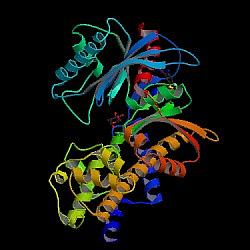*This page was created as an assignment for an undergraduate class at Davidson College*
Glucokinase: Structure and Function

Image provided by Protein Data Bank.
Introduction
Glucokinase (hexokinase D) is a monomeric cytoplasmic enzyme found in the liver and pancreas. Its main function is regulation of glucose levels in these organs. Through phosporylation glucokinase is able to increase the metabolism of glucose. In the liver it increases the synthesis of glycogen and is the first step in glycolysis, the main producer of ATP in the body. Due to the importance of glucose regulation, individuals who display an irregularity in glucokinase are often afflicted with Type-II diabetes, hypoglycemia, or hyperglycemia. (Kamata et al., 2004)
Function
Glucokinase is the glucose sensing enzyme in the liver and the pancreas. Glucokinase is responsible for phospohorylating the majority of glucose in the liver and pancreas. Glucokinase only binds to and phosphorylates glucose when levels are higher than normal blood glucose level, allowing it to maintain constant glucose levels (Kamata et al., 2004). By phosphorylating glucose, glucokinase creates glucose 6-phosphate. Glucose 6-phosphate can then be used by the liver through the glycolytic pathway (Devlin, 1982) (Figure 1). Along with this process in the liver, glucokinase also facilitates glycogen synthesis. Through this the majority of the body's glucose is stored . Glucose 6-phosphate is also one of the starting materials of the TCA cycle which is responsible for the majority of ATP production in the body (figure 1).

Figure 1: Metabolism of glucose in the liver (glycolysis pathway) Glucokinase is represented by Hexokinase in the first step in this diagram. Permission pending. http://biotech.icmb.utexas.edu/glycolysis/pathway.html
In the pancreas a rise in glucose levels, increases the activity of glucokinase, which causes and increase in glucose 6-phosphate, which then triggers the beta cells to secret insulin. (Postic et al., 2001) Glucokinase is the first step in this reaction. Insulin then allows other cells in the body to take up glucose actively lowering the glucose level. Glucokinase can also phosporylate other proteins, specifically hexoses. Glucokinase is inhibited by glucokinase regulatory protein, which becomes active in low glucose environments.
Structure
Glucokinase consists of one chain or subunit of 448 amino acids forming a monomeric molecule consisting of 13 alpha helices and 5 beta sheets that can phosporylate glucose and other hexoses (Kamata et al., 2004). The chain is folded into two distinct regions, a small and large domain (Kamata et al., 2004). Glucokinase has one active binding site for glucose and one for ATP, which is the energy source for phosphorylation (Figure 2). This active binding site is located between the small and large domains(Kamata et al., 2004). The carboxyl terminus is part of the alpha 13 helix, which codes for the region that forms half of the binding site for glucose (Kamata et al. , 2004). Glucokinase can be modulated to form an inactive and active complex. The inactive conformation forms when the alpha 13 helix has been modulated away from the rest of the molecule forming a large space (Kamata et al., 2004). This space is too large to bind glucose so it is said to be in the inactive form. The alternative is when the alpha 13 helix is modulated to form a smaller space thus activating the protein (Kamata et al., 2004).
Figure 2: Structure of glucokinase when binding ATP and glucose. Permission pending. http://asterix.cs.gsu.edu/~weber/GK-glc-atp03.gif
There are different isoforms of glucokinase one in the liver and one in the pancreas. Transcription of glucokinase is behind these differences as there are two promoters for glucokinase. These promoters are located at a large distance from each other upstream of the start transcription site. Each promoter is responsible for alternative splicing of the mRNA causing differences in the N-terminus (Postic et al., 2001)
AMINO ACID SEQUENCE OF GLUCOKINASE Courtesy of Protein Data Bank.
Complications resulting from a mutation in glucokinase
Hypoglycemia and hyperglycemia result from an altered non-functional glucokinase enzyme, (Zelent et al., 2005) specifically persistent hyperinsulinemic hypoglycemia in infants (PHHI) which is caused by a mutation in glucokinase (Postic et al., 2001) . Glucokinase plays an important role in diabetes, because it plays a role in glucose up take in the pancreas and liver which are defective in patients with type II diabetes. One drug company has targeted glucokinase and has found a way to turn this molecule "on" or make it active, providing a way to treat diabetes (Unknown, 2003).
References:
Devlin, Thomas. Ed. Textbook of Biochemistry: with clinical correlations. New York: Wiley Medical Publication. 1982.
Kamata K, Mitsuya M, Nishimura T, Eiki J, Nagata Y. 2004 March. Structural Basis for allosteric Regulation of the monomeric allosteric enzyme human Glucokinase. Structure 12(3):429-38.
Postic C, Shiota M, Magnuson MA. 2001. Cell-specific roles of glucokinase in glucose homeostasis. Recent Progress in Hormone Research 56:195-218. <http://rphr.endojournals.org/cgi/content/abstract/56/1/195> Last accessed Feb. 15, 2005.
Unknown. Protein Holds Promise as New Diabetes Drug Target: Chemical activates glucokinase enzyme and could improve insulin secretion. July 17, 2003. <http://diabetes.about.com/library/blnews/blnrochedrug703.htm> Last accessed on Feb. 15, 2005.
Zelent D, Najafi H, Odili S, Buettger C, Weik-Collins H, Li C, Doliba N, Grimsby J, Matschinsky FM. 2005 February. Glucokinase and glucose homeostasis: proven concepts and new ideas.Biochem Soc. Trans. 33(1):306-10. <http://www.ncbi.nlm.nih.gov/entrez/query.fcgi?cmd=Retrieve&db=pubmed&dopt=Abstract&list_uids=15667334> Last accessed on Feb. 15, 2005.
Any questions or concerns regarding this page should be directed to Matt Gemberling.